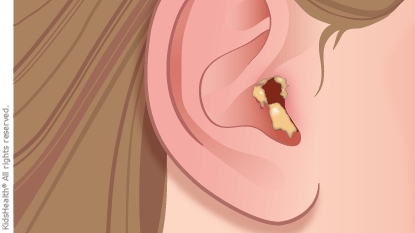Swimmer's Ear (External Otitis)
What Is Swimmer's Ear?
Swimmer's ear is an infection of the ear canal, the tubular opening that carries sounds from the outside of the body to the eardrum. It can be caused by different types of bacteria or fungi.
What Causes Swimmer's Ear?
Swimmer's ear — or otitis externa — usually develops in ears that are exposed to moisture. People who get it often have been diving or swimming a lot, which can bring germs directly into the ear canal. Swimmer's ear often happens during the summer months, when lots of us are enjoying water activities.
People who don't swim can also develop it by scratching their ear canals when they try to clean their ears. This is especially true if they use cotton swabs or dangerously sharp small objects, like hair clips or bobby pins.
Sometimes, in a person with a middle ear infection (otitis media), pus collected in the middle ear can drain into the ear canal through a hole in the eardrum, causing otitis externa.
What Are the Signs & Symptoms of Swimmer's Ear?
The main sign is severe ear pain that gets worse when the outside part of the ear is pulled or pressed on. Sometimes there is itching in the ear canal before the pain begins.

The outer ear might get red or swollen. Lymph nodes around the ear may get enlarged and tender. Sometimes, there's a greenish-yellow discharge of pus from the ear opening. It can be hard to hear in the affected ear if pus or swelling of the canal begins to block passage of sound into the ear.
How Long Does Swimmer's Ear Last?
Prescription ear drops usually cure swimmer's ear in 7–10 days. The pain should ease within a few days of starting treatment.
External otitis is not contagious, so you don't have to limit your contact with friends as long as you're feeling well enough to socialize.
When Should I Call My Doctor?
Call your doctor if you have any of these problems:
- pain in an ear with or without fever
- long-lasting itching of the ear or in the ear canal
- loss of hearing or decreased hearing in one or both ears
- discharge from an ear, especially if it's thick, discolored, bloody, or bad-smelling
Getting treatment is the fastest way to relieve the ear pain and stop the infection.
How Is Swimmer's Ear Treated?
How doctors treat swimmer's ear depends on how severe the pain and infection are. For most outer ear infections, they prescribe ear drops containing antibiotics possibly mixed with medicine to help ease swelling. These will fight the infection and help with pain. Ear drops typically are used several times a day for 7–10 days.
If swelling narrows the opening into the ear, the doctor may clean the ear and insert a sponge called a wick into the ear canal. It will carry ear drops into the ear more effectively. If you have a severe infection, you might also get antibiotic liquid or pills to swallow. Your doctor may send some of the fluid draining from your ear to a lab to find out which germ is causing the infection.
What Can I Do to Feel Better?
At home, follow your doctor's directions for using ear drops and take all doses of antibiotic medicine as prescribed. Keep taking these for all days of treatment, even if you start to feel better. If you stop too soon, the infection could come back.
You can take acetaminophen or ibuprofen for ear pain. If they don't help, let your doctor know. You'll only need pain medicine for a day or two — until the ear drops and antibiotics begin to work.
To protect your ear while it heals, your doctor will probably tell you to keep your ears dry for several days or weeks — even while showering or shampooing! This can be tough, but your doctor can give you suggestions on how to do this, such as using a cotton ball covered in petroleum jelly as an earplug.
Can Swimmer's Ear Be Prevented?
You may be able to prevent swimmer's ear by using over-the-counter acetic acid drops after you've finished swimming for the day. But don't use these drops if you have ear tubes or a hole in your eardrum. Dry your ears well with a clean towel after swimming, bathing, or showering. You also can use a hair dryer on the cool setting to dry the inside of the ears.
Keep all objects out of your ear canals — including cotton swabs — unless your doctor has told you it's OK to use them.


